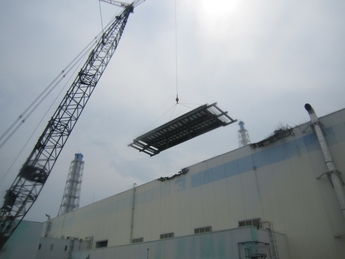As small-scale site remediation works such as patching the unit 3 turbine hall roof continue, electrical utility TEPCO has published an update of its progress in achieving short- and medium goals to stabilise the damaged Fukushima Daiichi site.

It has concluded that to achieve continuous cold shutdown of all reactors on the site, installation of a full-fledged water processing system, establishment of a groundwater contamination shielding wall, building a temporary cover for units 3&4, and mitigation of ocean contamination, among other tasks, could take three years.
TEPCO has reported that it has met all of the requirements of its first step, in that site radiation has fallen continuously, that reactors and spent fuel pools have stable cooling, and that treatment operations have begun of accumulated contaminated water. It has calculated provisionally that a worker on site would be exposed to 1.7 mSv/year (compared with the regulatory limit of 1 mSv/year). It said that if one assumes that all radiation detected is from current emissions, the release rate is about 1 billion Bq/hr; this is two millionths of the emission rate right after the accident.
TEPCO's step two stabilisation goals, expected to last from three to six months, include installing alternate spent fuel cooling systems at unit 1 and unit 4, installation and commissioning of two types of desalination systems (based on distillation and reverse osmosis), construction of a centralised monitoring system in the main anti-earthquake building, continuing pipe sheet pile drilling to permanently isolate the unit's intake bay from the sea, removing debris, evaluating the seismic resistance of reactor buildings and improvement of worker health monitoring, and consideration of a so-called 'full-fledged' water treatment system, among other work.
After noticing a drop in flow rate, TEPCO has begun work to flush the air out of the lines and into tanks. Connecting pipes with bellows have been replaced with smooth-walled pressure-resistant hoses, and ventilation lines have been added to the first treated water tank.




